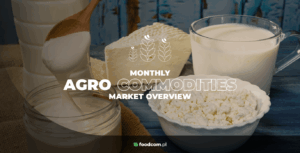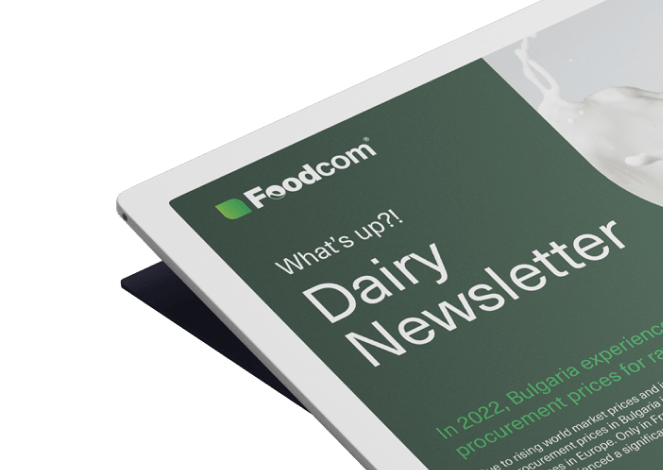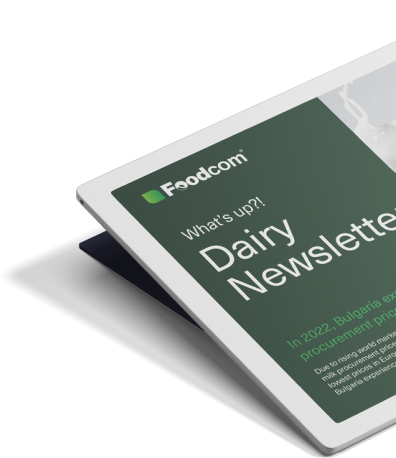- Dairy and grains remain under pressure from high supply, keeping prices low and margins tight.
- Coffee and cocoa remain high, driven by weather factors and logistical tensions.
- The chemical additives market remains stable, although it is increasingly feeling the impact of rising energy and transport costs.
- European processors are making cautious purchasing decisions, securing supplies for early 2026.
October 2025 was marked by increasing differences between commodity categories. Milk and cereals remained under pressure from high supply, while coffee and cocoa reacted to weather factors, keeping prices high. In chemical additives, there was relative stability, although the impact of energy and logistics costs became increasingly apparent.
For European companies, it was a month of balanced decisions: taking advantage of low prices in stable segments and hedging positions in riskier ones before the end of the year.
Dairy products
Milk production continued to grow in key regions. In the US, it reached 70.1 million tonnes, while export demand remained subdued. The latest GDT auction showed a slight cooling of sentiment, which reflects the situation well: the market is saturated but without sudden movements.
In Europe, the autumn influx of raw material increased stocks and kept pressure on most categories. Dairy fats continued the soft trend, although cream rebounded briefly thanks to a recovery in short-term contracts. In powders, sentiment was cool: SMP and WMP remained at a low base, with competition from Oceania limiting room for margin improvement.
Cheese saw slight price pressure, although EU retail demand remained stable, lower raw material prices and high supply meant that trade was in tight spreads with increased inventory discipline. The whey protein segment fared much better: concentrates and isolates benefited from sustained demand and limited supply, making them one of the few brighter spots of the month.
Bottom line: it is still a buyer’s market. October favoured renegotiations and securing volumes for the beginning of 2026, but the balance is fragile. Possible production cuts in countries with higher energy and feed costs could change the balance of power relatively quickly.
Cereals and starches
In the cereals market, October brought a marked calming down after a record harvest, but also an increasingly strong struggle for markets. Surpluses of wheat and maize in key producing regions are keeping pressure on prices, and global trade is shifting increasingly towards Asian and African buyers.
The European Union is entering the new season with exceptionally high stocks. Soft wheat yields have exceeded 136 million tonnes, the highest level in five years. This is causing increasing competition between exporters from France, Germany and the Black Sea region, where aggressive price offers from Ukraine and Russia are undercutting EU exports. An increasing proportion of EU grain is therefore going to feed processing and biogas plants instead of being exported.
On the maize market, the situation is similar. Good weather in central Europe and a drop in drying costs have increased the availability of raw material, while at the same time feed demand is not growing at a rate that would balance the market. As a result, pressure on warehouses is increasing, especially in Poland, Romania and Hungary, where processors expect price adjustments in the fourth quarter.
On a global level, IGC data show record cereal stocks of over 600 million tonnes. Nevertheless, some points of tension are evident: slowing logistics at Black Sea ports, delays in deliveries from Argentina and growing interest in maize imports in China. This could stabilise the market in the short term and limit further price falls.
For the feed and processing industry, this is a relatively comfortable period. Raw material costs remain low, but the focus is on the long-term profitability of exports. Key for the end of the year will be decisions on export volumes from Russia and Ukraine and the pace of Asian contracts, which will determine sentiment in the first quarter of 2026.
Coffee and cocoa
Coffee market
October in the coffee market brought clear tensions between increasing supply and continuing logistical uncertainty. Brazil’s harvest progressed faster than a year ago, but dry weather in the southern states began to take its toll on the quality of arabica beans. As a result, futures reacted to a drop in US certified stocks, which reached their lowest level in a decade. This triggered a short-lived price rebound, although the market remains highly sensitive to weather data.
In Vietnam, record harvest forecasts for robusta – despite lingering drought concerns in the Dak Lak region – are easing tensions on the global balance sheet, shifting some buying towards cheaper varieties.
A shift in export destinations is increasingly evident in international trade. Brazilian exporters are reducing shipments to Europe, diverting higher volumes to the US and Japan, where exchange rate differences are improving margins. At the same time, roasters in Germany, Italy and Poland are increasing their purchases in Central America, particularly Honduras and Guatemala, to maintain a continuous supply of high-quality arabica. High freight rates from South America to Europe and rising inventory financing costs are causing many importers to adopt a tiered purchasing model – combining short spot deliveries with long-term contracts for the first months of 2026.
Cocoa market
After months of sharp increases and subsequent correction, October 2025 brought a period of volatile but generally stabilising conditions in the cocoa market. During the first half of the month, prices remained around USD 6 000 per tonne, continuing the downward trend started in the summer. However, at the end of October, quotations rose again, reaching around USD 6 500/tonne, close to the highest values since the beginning of the month. The rise was supported by a decline in ICE-monitored certified stocks at US ports (to the lowest level in seven months) and the announcement of cocoa’s return to the Bloomberg Commodity Index, which may attract additional capital from investment funds.
At the same time, there were mixed signals from West Africa. Bean purchases remain low as farmers in Côte d’Ivoire and Ghana hold back sales in anticipation of further increases in guaranteed prices. Some stocks from the previous season are of reduced quality due to excessive moisture and storage problems. Nevertheless, optimistic harvest forecasts, the result of a good balance between rainfall and sunshine, raise hopes for an improvement in supply in the October-March season.
European importers continue to signal difficulties in maintaining quality standards and longer delivery times, particularly at the ports of Abidjan and Takoradi. In this situation, alternative suppliers such as Ecuador, Brazil and the Dominican Republic are growing in importance, although their competitiveness is still limited by high sea transport costs.
Additions
The functional and chemical additives market showed relative price stability, although the industry remains vigilant against tensions in supply chains and rising energy costs. Producers in Asia, particularly China, which accounts for more than 60 per cent of the world’s vitamin supply, have been working at reduced capacity, extending delivery times to Europe. As a result, importers are more likely to secure contracts in advance to avoid the risk of logistical disruptions.
Vitamin C (ascorbic acid) was in the spotlight, with the price in Europe hovering around US$3/kg. The European Union remains fully dependent on imports of this vitamin, with global production concentrated in Asia. Despite a seasonal increase in demand in the pharmaceutical and supplement sectors, the market remained balanced. Price pressures were mitigated by weakening feed demand. At the end of the month, EFSA confirmed the safety of ascorbic acid and its salts, paving the way for the renewal of authorisation in 2026.
In the market for citric acid, a key preservative and pH regulator, prices remained stable in the region of US$1.8/kg, despite rising energy costs. The majority of EU supplies continue to come from China and the import structure remains unchanged.
The amino acid and bioactive compounds segment(taurine, creatine, L-carnitine) saw a slight recovery in orders in the supplement industry, driven by an autumn increase in demand. However, Asian suppliers reduced spot sales, preferring long-term contracts.
The month ended with the European Commission’s decision to extend the authorisation of propionic acid and its salts to all animal species, which could reduce the cost of feed and food preservation in the long term.
Overall, the additives market remains price stable but operationally tight. High energy costs and the concentration of production in Asia make security of supply, not price, the most important factor for companies at the end of the year.
Summary and forecasts
October 2025 has perpetuated the differentiation between agricultural commodity market segments. In dairy, oversupply and low export activity persists, while coffee and cocoa remain weather and structural influences, keeping prices high. Cereals and starches benefit from good supply, while chemical additives, despite stable quotations, are increasingly affected by rising energy costs and logistical tensions.
For European processors, the end of the year promises to be a period of greater caution. In sectors with oversupply, contract renegotiations are possible, while in highly volatile categories such as coffee, cocoa or vitamins, hedging and flexible pricing formulas become crucial.
Three factors will determine the direction of the market in the final weeks of the year: the rate of decline in milk production in Europe, the weather in South America and the stability of shipments from Asia. The global supply balance remains positive, but the market is entering a phase of increasing volatility, and companies that have hedged their prices and supply chain earlier will gain the advantage.
![Monthly review of the agricultural commodities market [October] Monthly review of the agricultural commodities market [October]](https://foodcom.pl/wp-content/uploads/2025/11/Agro-Commodities-min-1520x760.png)


![Miesięczny przegląd rynku surowców rolnych [Sierpień] Miesięczny przegląd rynku surowców rolnych [Sierpień]](https://foodcom.pl/wp-content/uploads/2025/09/monthly-agro-commodities-august-300x153.png)
![Miesięczny przegląd rynku surowców rolnych [Lipiec] Miesięczny przegląd rynku surowców rolnych [Lipiec]](https://foodcom.pl/wp-content/uploads/2025/08/monthly-agro-commodities-market-overview-300x153.png)



